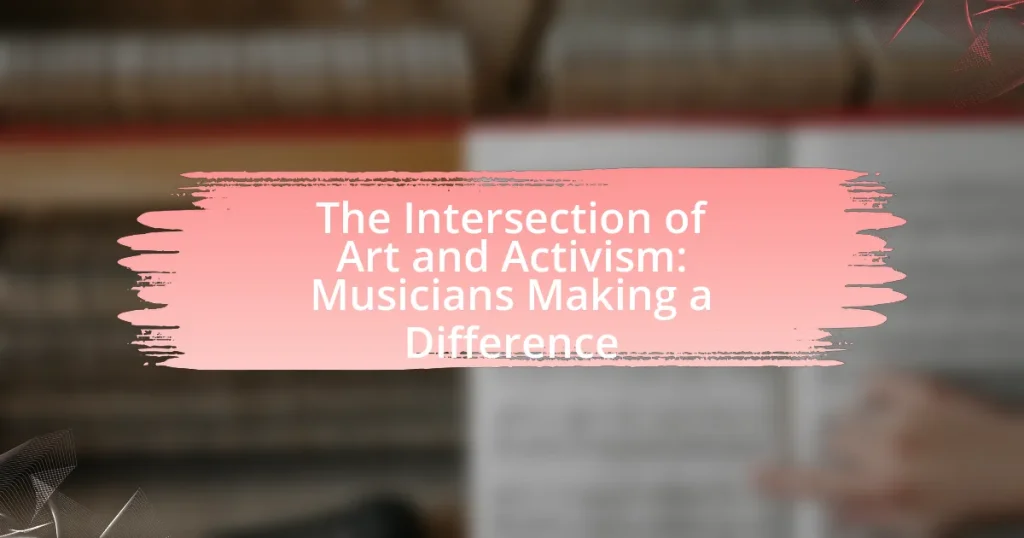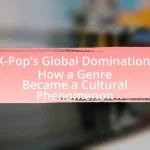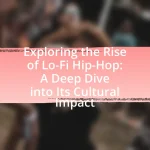The article explores the intersection of art and activism in music, highlighting how musicians utilize their creative expression to address social, political, and cultural issues. It examines historical and contemporary examples of artists like Bob Dylan, Public Enemy, and Kendrick Lamar, who have mobilized audiences and inspired social change through their work. The piece discusses various forms of musical activism, the influence of different genres, and the strategies musicians employ to amplify their messages. Additionally, it addresses the challenges artists face in their activism and outlines best practices for ensuring their efforts are authentic and impactful.
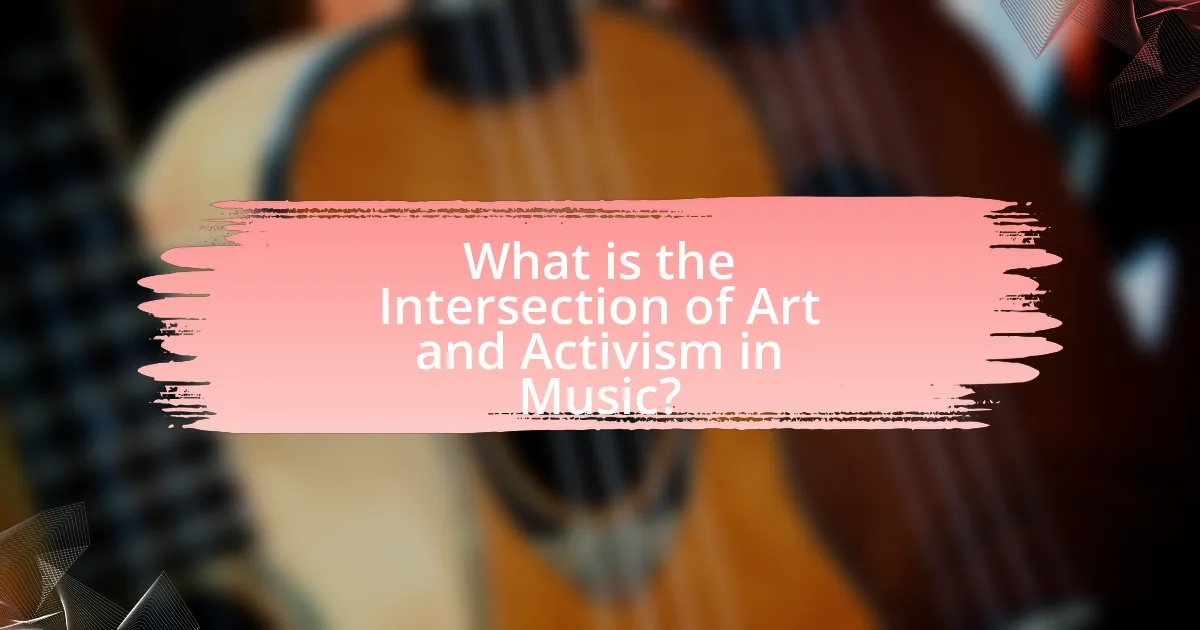
What is the Intersection of Art and Activism in Music?
The intersection of art and activism in music occurs when musicians use their creative expression to address social, political, and cultural issues, aiming to inspire change and raise awareness. This relationship is evident in various genres, such as folk, hip-hop, and punk, where artists like Bob Dylan, Public Enemy, and Rage Against the Machine have historically used their platforms to challenge injustices and mobilize audiences. For instance, Bob Dylan’s “The Times They Are a-Changin'” became an anthem for the civil rights movement, illustrating how music can serve as a powerful tool for activism.
How do musicians use their art to promote social change?
Musicians use their art to promote social change by creating songs and performances that address social issues, raise awareness, and inspire action. For instance, artists like Bob Dylan and Public Enemy have historically used their music to comment on civil rights and social justice, effectively mobilizing listeners to engage in activism. Research shows that music can influence public opinion and motivate collective action, as seen in movements like the Civil Rights Movement, where songs became anthems for change. Additionally, contemporary musicians often leverage social media platforms to amplify their messages, reaching wider audiences and fostering community engagement around critical issues such as climate change, racial equality, and mental health awareness.
What are some historical examples of musicians as activists?
Musicians have historically played significant roles as activists, using their platforms to advocate for social and political change. For example, Bob Dylan’s song “The Times They Are a-Changin'” became an anthem for the civil rights movement in the 1960s, encouraging social reform and activism. Similarly, Joan Baez was a prominent figure in the anti-war movement, participating in protests and using her music to raise awareness about issues such as the Vietnam War. Another notable example is the band U2, whose lead singer Bono has been actively involved in campaigns against poverty and disease in Africa, notably through the ONE Campaign. These instances illustrate how musicians have effectively utilized their art to influence public opinion and drive social change.
How does music serve as a platform for political messages?
Music serves as a platform for political messages by conveying social and political themes through lyrics, melodies, and performances. Artists often use their music to address issues such as inequality, war, and human rights, effectively reaching a wide audience and inspiring action. For instance, songs like “Fight the Power” by Public Enemy and “Imagine” by John Lennon have become anthems for social movements, illustrating how music can mobilize listeners and foster a sense of community around political causes. Historical examples show that during the Civil Rights Movement, artists like Nina Simone and Bob Dylan used their music to highlight injustices, influencing public opinion and encouraging activism.
Why is the role of musicians in activism significant?
The role of musicians in activism is significant because they possess the unique ability to influence public opinion and mobilize communities through their art. Musicians often use their platforms to raise awareness about social issues, as seen in historical movements like the Civil Rights Movement, where artists such as Nina Simone and Bob Dylan used their music to inspire change and solidarity. Additionally, studies show that music can evoke emotional responses, making messages more impactful; for instance, a 2018 study published in the Journal of Music and Social Movements highlights how songs can serve as powerful tools for collective identity and action. Thus, musicians play a crucial role in shaping cultural narratives and driving social change.
What impact do musicians have on public opinion and awareness?
Musicians significantly influence public opinion and awareness by using their platforms to address social issues and inspire change. For instance, artists like Bob Dylan and Kendrick Lamar have shaped cultural narratives through their lyrics, which often reflect societal challenges and injustices. Research indicates that music can enhance emotional engagement, making audiences more receptive to messages about political and social issues. A study published in the Journal of Communication found that music can effectively mobilize listeners, leading to increased activism and awareness around topics such as civil rights and climate change. Thus, musicians play a crucial role in shaping public discourse and fostering social consciousness.
How do musicians inspire action through their work?
Musicians inspire action through their work by using their art to raise awareness about social issues and motivate audiences to engage in activism. For instance, songs like “Fight the Power” by Public Enemy and “Alright” by Kendrick Lamar address systemic racism and police brutality, galvanizing listeners to participate in movements like Black Lives Matter. Research indicates that music can evoke strong emotional responses, which can lead to increased motivation for social change, as shown in studies published in the Journal of Music Therapy. Furthermore, musicians often leverage their platforms to advocate for causes, mobilizing fans through concerts, social media campaigns, and collaborations with non-profit organizations, thereby creating a direct link between their artistic expression and tangible social action.
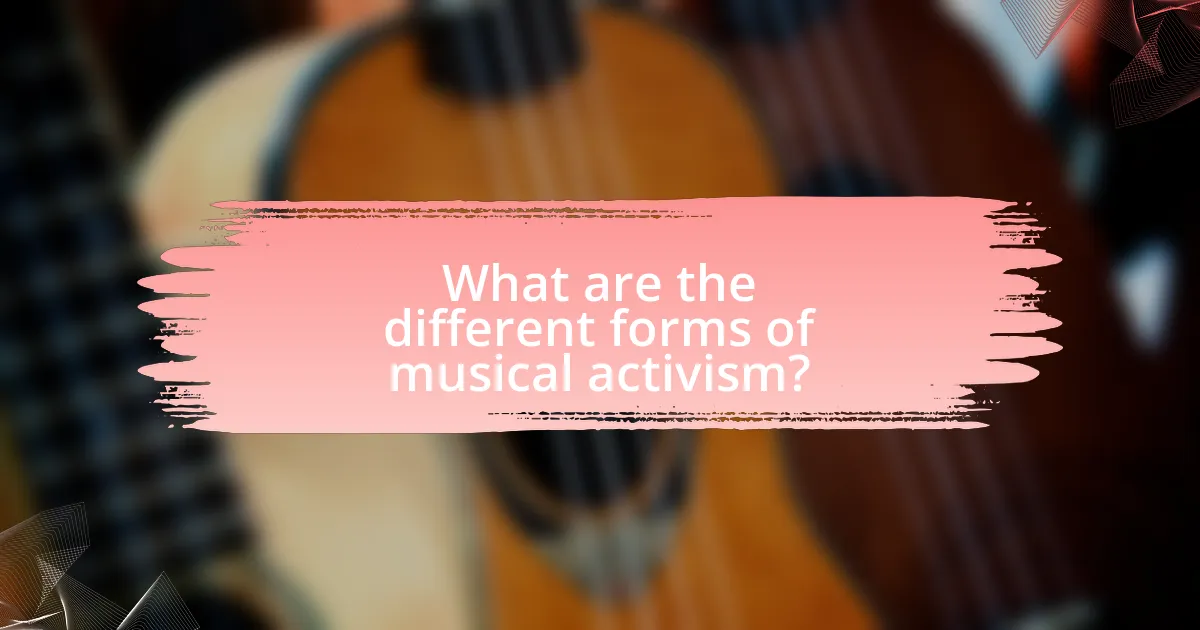
What are the different forms of musical activism?
Musical activism takes various forms, including protest songs, benefit concerts, and community engagement initiatives. Protest songs, such as Bob Dylan’s “Blowin’ in the Wind,” have historically addressed social and political issues, influencing public opinion and mobilizing movements. Benefit concerts, like Live Aid in 1985, raise funds and awareness for specific causes, demonstrating the power of music to unite people for a common goal. Additionally, community engagement initiatives, such as music workshops and educational programs, empower marginalized groups by providing them a platform to express their experiences and advocate for change. These forms of musical activism illustrate how artists leverage their craft to address societal issues and inspire action.
How do genres of music influence activist messages?
Genres of music significantly influence activist messages by shaping the emotional tone, accessibility, and cultural resonance of the messages conveyed. For instance, genres like hip-hop often utilize rhythmic and lyrical complexity to address social injustices, as seen in the works of artists like Kendrick Lamar, whose songs tackle systemic racism and inequality. In contrast, folk music traditionally emphasizes storytelling and communal experiences, exemplified by artists like Joan Baez, who used her platform to advocate for civil rights and anti-war movements in the 1960s. The genre’s characteristics, such as tempo, instrumentation, and lyrical style, directly affect how audiences perceive and engage with the activist messages, making them more relatable or urgent. Thus, the choice of genre can enhance the effectiveness of activism by aligning the message with the cultural and emotional contexts of the audience.
What role does hip-hop play in social justice movements?
Hip-hop plays a crucial role in social justice movements by serving as a powerful platform for marginalized voices and raising awareness about systemic injustices. Through lyrics, artists address issues such as police brutality, racial inequality, and economic disparity, effectively mobilizing communities and inspiring activism. For instance, songs like “Fight the Power” by Public Enemy and “Alright” by Kendrick Lamar have become anthems for movements like Black Lives Matter, illustrating how hip-hop can galvanize public sentiment and foster solidarity. The genre’s roots in resistance and storytelling enable it to communicate complex social issues in a relatable manner, making it an essential tool for advocacy and change.
How does folk music reflect grassroots activism?
Folk music reflects grassroots activism by serving as a powerful medium for social and political expression, often addressing issues of injustice and inequality. Historically, folk songs have been used to mobilize communities, raise awareness, and inspire collective action, as seen during the Civil Rights Movement in the United States, where artists like Pete Seeger and Joan Baez used their music to advocate for change. The lyrics of folk songs frequently narrate the struggles of ordinary people, making them relatable and fostering a sense of solidarity among listeners. This connection between folk music and grassroots activism is evident in its ability to convey messages of resistance and hope, thus reinforcing the role of music as a catalyst for social movements.
What are some notable campaigns led by musicians?
Notable campaigns led by musicians include Live Aid, organized by Bob Geldof and Midge Ure in 1985 to raise funds for famine relief in Ethiopia, which raised over $125 million. Another significant campaign is the “One Campaign,” co-founded by Bono of U2, aimed at alleviating global poverty and preventable disease, which has mobilized millions of supporters and influenced policy changes. Additionally, the “March for Our Lives” campaign, supported by artists like Ariana Grande and Lin-Manuel Miranda, advocates for gun control and youth activism following the Parkland school shooting in 2018. These campaigns demonstrate the powerful role musicians play in addressing social issues and mobilizing public support.
Which musicians have successfully mobilized their audiences for causes?
Musicians such as Bono, Taylor Swift, and Chance the Rapper have successfully mobilized their audiences for various causes. Bono, through his work with the organization ONE, has raised awareness and funds for global poverty and disease, engaging millions of fans in advocacy efforts. Taylor Swift has used her platform to promote voter registration and LGBTQ+ rights, notably encouraging her followers to participate in elections. Chance the Rapper has mobilized support for education funding in Chicago, leveraging his influence to advocate for local schools and community initiatives. These musicians exemplify how artists can effectively engage their audiences in meaningful social and political causes.
How do collaborations between artists enhance activism efforts?
Collaborations between artists enhance activism efforts by amplifying messages and reaching broader audiences. When artists unite, they combine diverse perspectives and creative styles, which can lead to more impactful and resonant expressions of social issues. For instance, the collaboration between musicians and visual artists in campaigns like “Artists for Peace” has successfully raised awareness and funds for various causes, demonstrating that collective creativity can mobilize communities and inspire action. This synergy not only increases visibility but also fosters a sense of solidarity among activists and supporters, ultimately strengthening the overall impact of their efforts.
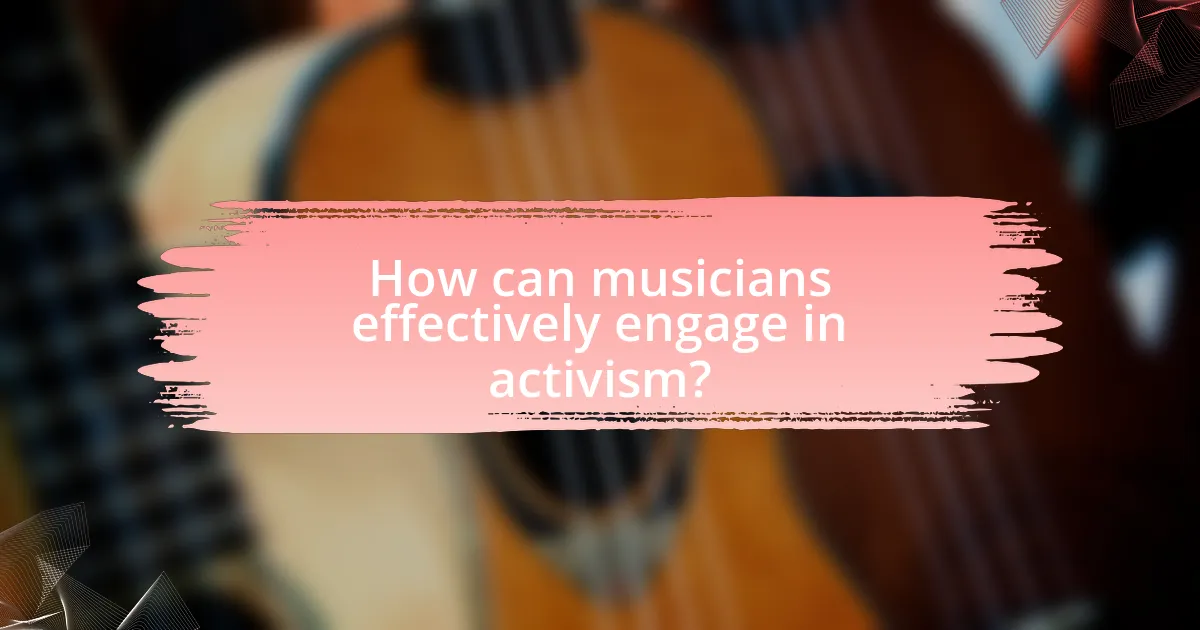
How can musicians effectively engage in activism?
Musicians can effectively engage in activism by using their platform to raise awareness about social issues through their music, performances, and public statements. For instance, artists like Billie Eilish and Kendrick Lamar have addressed topics such as climate change and racial inequality in their songs, which not only informs their audience but also inspires action. Additionally, musicians can collaborate with organizations, participate in benefit concerts, and leverage social media to mobilize their fan base for causes they support. Research shows that music can influence public opinion and motivate collective action, making it a powerful tool for activism.
What strategies can musicians use to amplify their message?
Musicians can amplify their message by leveraging social media platforms to reach wider audiences and engage with fans directly. For instance, artists like Chance the Rapper have utilized Twitter and Instagram to promote social causes, resulting in increased awareness and support for issues such as education reform. Additionally, collaborating with other artists and activists can enhance visibility; for example, the song “This Is America” by Childish Gambino sparked discussions on gun violence and racism, showcasing the power of music in activism. Furthermore, hosting benefit concerts or participating in charity events can mobilize communities and raise funds for specific causes, as seen with Live Aid in 1985, which raised millions for famine relief in Ethiopia. These strategies demonstrate how musicians can effectively use their platforms to amplify their messages and drive social change.
How can social media be leveraged for activist purposes?
Social media can be leveraged for activist purposes by facilitating communication, mobilizing supporters, and amplifying messages. Activists utilize platforms like Twitter, Facebook, and Instagram to share information rapidly, organize events, and create awareness around social issues. For instance, the #BlackLivesMatter movement gained significant traction through social media, allowing activists to reach a global audience and mobilize protests effectively. Additionally, studies show that social media campaigns can increase engagement and participation in social movements, as seen in the Arab Spring, where platforms were crucial for coordinating protests and disseminating information.
What role do live performances play in activism?
Live performances serve as powerful platforms for activism by raising awareness, mobilizing communities, and fostering emotional connections to social issues. Through concerts and events, artists can engage audiences directly, often addressing critical topics such as climate change, racial justice, and human rights. For instance, the 1985 Live Aid concert raised over $125 million for famine relief in Ethiopia, demonstrating how live music can galvanize public support and action. Additionally, performances often create a shared experience that unites individuals around a common cause, amplifying the message and encouraging collective action.
What challenges do musicians face in their activism?
Musicians face several challenges in their activism, including public scrutiny, financial risks, and the potential for backlash from fans or industry stakeholders. Public scrutiny can lead to intense criticism or misinterpretation of their messages, which may hinder their ability to advocate effectively. Financial risks arise when musicians align with controversial causes, potentially alienating portions of their audience and impacting ticket sales or streaming revenue. Additionally, backlash from fans or industry stakeholders can manifest as social media attacks or loss of support from record labels, making it difficult for musicians to maintain their careers while pursuing activism. These challenges highlight the complex landscape musicians navigate when integrating their art with social and political advocacy.
How can musicians navigate backlash or criticism for their views?
Musicians can navigate backlash or criticism for their views by engaging in open dialogue and demonstrating a willingness to listen to opposing perspectives. This approach fosters understanding and can mitigate negative reactions. For instance, artists like Taylor Swift have addressed criticism by articulating their viewpoints through social media and interviews, which allows them to clarify their intentions and connect with their audience. Additionally, musicians can use their platforms to promote constructive conversations, as seen when artists participate in panels or community discussions, thereby transforming backlash into opportunities for education and awareness.
What are the risks of political engagement for artists?
Political engagement for artists carries significant risks, including censorship, backlash from audiences, and potential harm to their careers. Artists who express political views may face censorship from institutions or platforms that disagree with their stance, limiting their ability to share their work. Additionally, they may encounter backlash from segments of their audience, leading to loss of support or financial repercussions. For instance, musicians like the Dixie Chicks faced severe backlash after criticizing President George W. Bush, resulting in a decline in their popularity and sales. Furthermore, artists may risk their safety, especially in oppressive regimes where dissent is not tolerated, as seen with artists in countries like Iran or China who have faced imprisonment for their political expressions.
What are best practices for musicians involved in activism?
Musicians involved in activism should prioritize authenticity, collaboration, and community engagement. Authenticity ensures that their message resonates with their audience, as seen in the work of artists like Billie Eilish, who openly discusses mental health issues, creating a genuine connection with fans. Collaboration with established organizations amplifies their impact; for instance, musicians like Chance the Rapper have partnered with local charities to address social issues effectively. Community engagement is crucial, as musicians can mobilize their fan base for grassroots initiatives, exemplified by the efforts of artists like Bruce Springsteen, who has historically used concerts to raise funds for various causes. These best practices enhance the effectiveness of musicians’ activism and foster a deeper connection with their audience.
How can musicians ensure their activism is authentic and impactful?
Musicians can ensure their activism is authentic and impactful by aligning their messages with their personal values and lived experiences. Authenticity stems from genuine engagement with the causes they support, which resonates more deeply with audiences. For instance, artists like Billie Eilish and Chance the Rapper have effectively used their platforms to advocate for mental health awareness and social justice, respectively, drawing from their own experiences and backgrounds. This connection fosters trust and encourages listeners to engage with the issues presented. Additionally, musicians should collaborate with grassroots organizations and communities directly affected by the issues they address, ensuring that their activism is informed and relevant. Research indicates that when artists actively participate in community initiatives, their influence can lead to increased awareness and mobilization around critical social issues.
What resources are available for musicians looking to make a difference?
Musicians looking to make a difference can access various resources, including nonprofit organizations, grants, and online platforms dedicated to social change. Organizations like Musicians on Call provide opportunities for musicians to perform for patients in healthcare settings, while the Sweet Relief Musicians Fund offers financial assistance to musicians in need. Additionally, platforms such as Patreon and GoFundMe enable musicians to raise funds for causes they support. These resources empower musicians to leverage their art for activism, fostering community engagement and social impact.
